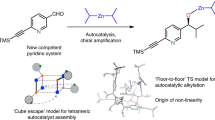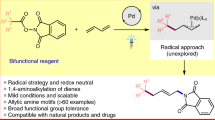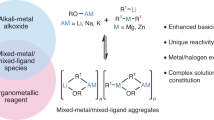Abstract
Small organic and metal-containing molecules (molecular mass <1,000) can catalyse synthetically useful reactions with the high levels of stereoselectivity typically associated with macromolecular enzymatic catalysts. Whereas enzymes are generally understood to accelerate reactions and impart selectivity as they stabilize specific transition structures through networks of cooperative interactions, enantioselectivity with chiral, small-molecule catalysts is rationalized typically by the steric destabilization of all but one dominant pathway. However, it is increasingly apparent that stabilizing effects also play an important role in small-molecule catalysis, although the mechanistic characterization of such systems is rare. Here, we show that arylpyrrolidino amido thiourea catalysts catalyse the enantioselective nucleophilic ring opening of episulfonium ions by indoles. Evidence is provided for the selective transition-state stabilization of the major pathway by the thiourea catalyst in the rate- and selectivity-determining step. Enantioselectivity is achieved through a network of attractive anion binding, cation-π and hydrogen-bond interactions between the catalyst and the reacting components in the transition-structure assembly.
This is a preview of subscription content, access via your institution
Access options
Subscribe to this journal
Receive 12 print issues and online access
$259.00 per year
only $21.58 per issue
Buy this article
- Purchase on Springer Link
- Instant access to full article PDF
Prices may be subject to local taxes which are calculated during checkout





Similar content being viewed by others
References
Zhang, Z. G. & Schreiner, P. R. (Thio)urea organocatalysis – what can be learnt from anion recognition? Chem. Soc. Rev. 38, 1187–1198 (2009).
Reisman, S. E., Doyle, A. G. & Jacobsen, E. N. Enantioselective thiourea-catalyzed additions to oxocarbenium ions. J. Am. Chem. Soc. 130, 7198–7199 (2008).
Brown, A. R., Kuo, W-H. & Jacobsen, E. N. Enantioselective catalytic α-alkylation of aldehydes via an SN1 pathway. J. Am. Chem. Soc. 132, 9286–9288 (2010).
De, C. K., Klauber, E. G. & Seidel, D. Merging nucleophilic and hydrogen bonding catalysis: an anion binding approach to the kinetic resolution of amines. J. Am. Chem. Soc. 131, 17060–17061 (2009).
Knowles, R. R. & Jacobsen, E. N. Attractive noncovalent interactions in asymmetric catalysis: links between enzymes and small molecule catalysts. Proc. Natl Acad. Sci. USA 107, 20678–20685 (2010).
Knowles, R. R., Lin, S. & Jacobsen, E. N. Enantioselective thiourea-catalyzed cationic polycyclizations. J. Am. Chem. Soc. 132, 5030–5032 (2010).
Zuend, S. J. & Jacobsen, E. N. Mechanism of amido-thiourea catalyzed enantioselective imine hydrocyanation: transition state stabilization via multiple non-covalent interactions. J. Am. Chem. Soc. 131, 15358–15374 (2009).
Fox, D. J., House, D. & Warren, S. Mechanisms of sulfanyl (RS) migrations: synthesis of heterocycles. Angew. Chem. Int. Ed. 41, 2462–2482 (2002).
Smit, W. A., Caple, R. & Smoliakova, I. P. Stepwise electrophilic addition. Some novel synthetic ramifications of an old concept. Chem. Rev. 94, 2359–2382 (1994).
Fachini, M., Lucchini, V., Modena, G., Pasi, M. & Pasquato, L. Nucleophilic reactions at the sulfur of thiiranium and thiirenium ions. New insight in the electrophilic additions to alkenes and alkynes. Evidence for an episulfurane intermediate. J. Am. Chem. Soc. 121, 3944–3950 (1999).
Toshimitsu, A., Hirosawa, C. & Tamao, K. Retention of configuration in the Ritter-type substitution reaction of chiral/3-arylthio alcohols through the anchimeric assistance of the arylthio group. Tetrahedron 50, 8997–9008 (1994).
Hamilton, G. L., Kanai, T. & Toste, F. D. Chiral anion-mediated asymmetric ring opening of meso-aziridinium and episulfonium ions. J. Am. Chem. Soc. 130, 14984–14986 (2008).
Wu, Y. J. in Heterocyclic Scaffolds II: Topics in Heterocyclic Chemistry Vol. 26 (ed. Gribble, G. W.) 1–29 (Springer, 2011).
Uyeda, C. & Jacobsen, E. N. Transition-state charge stabilization through multiple non-covalent interactions in the guanidinium-catalyzed enantioselective Claisen rearrangement. J. Am. Chem. Soc. 133, 5062–5075 (2011).
Denmark, S. E., Kornfilt, D. J. P. & Vogler, T. Catalytic asymmetric thiofunctionalization of unactivated alkenes. J. Am. Chem. Soc. 133, 15308–15311 (2011).
Denmark, S. E., Collins, W. R. & Cullen, M. D. Observation of direct sulfenium and selenenium group transfer from thiiranium and seleniranium ions to alkenes. J. Am. Chem. Soc. 131, 3490–3492 (2009).
Denmark, S. E. & Vogler, T. Synthesis and reactivity of enantiomerically enriched thiiranium ions. Chem. Eur. J. 15, 11737–11745 (2009).
Lucchini, V., Modena, G. & Pasquato, L. Enantiopure thiosulfonium salts in asymmetric synthesis. Face selectivity in electrophilic additions to unfunctionalised olefins. J. Chem. Soc. Chem. Commun. 1565–1566 (1994).
Mayr, H., Kempf, B. & Ofial, A. R. π-nucleophilicity in carbon–carbon bond-forming reactions. Acc. Chem. Res. 36, 66–77 (2003).
Birrell, J. A., Desrosiers, J-N. & Jacobsen, E. N. Enantioselective acylation of silyl ketene acetals through fluoride anion-binding catalysis. J. Am. Chem. Soc. 133, 13872–13875 (2011).
Blackmond, D. G. Reaction progress kinetic analysis: a powerful methodology for mechanistic studies of complex catalytic reactions. Angew. Chem. Int. Ed. 44, 4302–4320 (2005).
Blackmond, D. G., Ropic, M. & Stefinovic, M. Kinetic studies of the asymmetric transfer hydrogenation of imines with formic acid catalyzed by Rh-diamine catalysts. Org. Process Res. Dev. 10, 457–463 (2006).
Denmark, S. E. & Burk, M. T. Lewis base catalysis of bromo- and iodolactonization, and cycloetherification. Proc. Natl Acad. Sci. USA 107, 20655–20660 (2010).
French, D. C. & Crumrine, D. S. Improved correlation of 33S chemical shifts with pKas of arenesulfonic acids: use of 33S NMR for pKa determination. J. Org. Chem. 55, 5494–5496 (1990).
Phan, T. B., Breugst, M. & Mayr, H. Towards a general scale of nucleophilicity? Angew. Chem. Int. Ed. 45, 3869–3874 (2006).
Maresh, J. J. et al. Strictosidine synthase mechanism of a Pictet–Spengler catalyzing enzyme. J. Am. Chem. Soc. 130, 710–723 (2008).
Bosnich, B. Asymmetric Catalysis 14 (Marinus Nijhoff, 1986).
Kelly, T. R. & Kim, M. H. Relative binding affinity of carboxylate and its isosteres: nitro, phosphate, phosphonate, sulfonate, and δ-lactone. J. Am. Chem. Soc. 116, 7072–7080 (1994).
Xu, H., Zuend, S. J., Woll, M. G., Tao, Y. & Jacobsen, E. N. Asymmetric cooperative catalysis of strong Brønsted acid-promoted reactions using chiral ureas. Science 327, 986–990 (2010).
Scheerder, J., Engbersen, J. F. J., Casnati, A., Ungaro, R. & Reinhoudt, D. N. Complexation of halide anions and tricarboxylate anions by neutral urea-derivatized p-tert-butylcalix[6]arenes. J. Org. Chem. 60, 6448–6454 (1995).
Lan, T. & McLaughlin, L. W. The energetic contribution of a bifurcated hydrogen bond to the binding of DAPI to dA-dT rich sequences of DNA. J. Am. Chem. Soc. 123, 2064–2065 (2001).
Braun, J., Neusser, H. J. & Hobza, P. N–H···π interactions in indole···benzene-h6,d6 and indole···benzene-h6,d6 radical cation complexes. Mass analyzed threshold ionization experiments and correlated ab initio quantum chemical calculations. J. Phys. Chem. A 107, 3918–3924 (2003).
Biswal, H. S. & Wategaonkar, S. Nature of the N–H···S hydrogen bond. J. Phys. Chem. A 113, 12763–12773 (2009).
Herrera, R. P., Sgarzani, V., Bernardi, L. & Ricci, A. Catalytic enantioselective Friedel–Crafts alkylation of indoles with nitroalkenes by using a simple thiourea organocatalyst. Angew. Chem. Int. Ed. 44, 6576–6579 (2005).
James, W. H. III et. al. Evolution of amide stacking in larger γ-peptides: triamide H-bonded cycles. J. Phys. Chem. A 115, 13783–13798 (2011).
Gustafson, J., Lim, D. & Miller, S. J. Dynamic kinetic resolution of biaryl atropisomers via peptide-catalyzed asymmetric bromination. Science 328, 1251–1255 (2010).
Shepodd, T. J., Petti, M. A. & Dougherty, D. A. Tight, oriented binding of an aliphatic guest by a new class of water-soluble molecules with hydrophobic binding sites. J. Am. Chem. Soc. 108, 6085–6087 (1986).
Kearney, P. C. et al. Molecular recognition in aqueous media. New binding studies provide further insights into the cation-π interaction and related phenomena. J. Am. Chem. Soc. 115, 9907–9919 (1993).
Ma, J. C. & Dougherty, D. A. The cation-π interaction. Chem. Rev. 97, 1303–1324 (1997).
Dougherty, D. A. Cation-π interactions in chemistry and biology: a new view of benzene, Phe, Tyr, and Trp. Science 271, 163–168 (1996).
Raju, R. K., Bloom, J. W. G., An, Y. & Wheeler, S. E. Substituent effects on non-covalent interactions with aromatic rings: insights from computational chemistry. ChemPhysChem 12, 3116–3130 (2011).
Xiu, X., Puskar, N. L., Shanata, J. A. P., Lester, H. A. & Dougherty, D. A. Nicotine binding to brain receptors requires a strong cation-π interaction. Nature 458, 534–538 (2009).
Vijay, D. & Sastry, G. N. Exploring the size dependence of cyclic and acyclic π-systems on cation-π binding. Phys. Chem. Chem. Phys. 10, 582–590 (2008).
Gal, J-F. et al. Lithium-cation/π complexes of aromatic systems. The effect of increasing the number of fused rings. J. Am. Chem. Soc. 125, 10394–10401 (2003).
Li, X., Liu, P., Houk, K. N. & Birman, V. B. Origin of enantioselectivity in CF3–PIP-catalyzed kinetic resolution of secondary benzylic alcohols. J. Am. Chem. Soc. 130, 13836–13837 (2008).
Ngola, S. M. & Dougherty, D. A. Evidence for the importance of polarizability in biomimetic catalysis involving cyclophane receptors. J. Org. Chem. 61, 4355–4360 (1996).
Acknowledgements
This work was supported by the National Institute of General Medical Sciences (NIGMS) (P50 GM-69721 and RO1 GM-43214) and by a predoctoral fellowship to S.L. from Eli Lilly. We thank R. Knowles, K. Brak and H. Mayr for helpful discussions, A. Brown, D. Lehnherr and A. Hyde for the use of catalysts, and S-L. Zheng for crystal structure determinations.
Author information
Authors and Affiliations
Contributions
S.L. conducted the experiments, S.L. and E.N.J. co-wrote the manuscript and E.N.J. guided the research.
Corresponding author
Ethics declarations
Competing interests
The authors declare no competing financial interests.
Supplementary information
Supplementary information
Supplementary information (PDF 5704 kb)
Supplementary information
Crystallographic data for compound 2b (CIF 29 kb)
Supplementary information
Crystallographic data for compound 2g (CIF 16 kb)
Supplementary information
Crystallographic data for compound 2q (CIF 29 kb)
Rights and permissions
About this article
Cite this article
Lin, S., Jacobsen, E. Thiourea-catalysed ring opening of episulfonium ions with indole derivatives by means of stabilizing non-covalent interactions. Nature Chem 4, 817–824 (2012). https://doi.org/10.1038/nchem.1450
Received:
Accepted:
Published:
Issue Date:
DOI: https://doi.org/10.1038/nchem.1450
This article is cited by
-
Polarizability matters in enantio-selection
Nature Communications (2024)
-
Anion-binding catalysis enables living cationic polymerization
Nature Synthesis (2022)
-
Organocatalyst-controlled site-selective arene C–H functionalization
Nature Chemistry (2021)
-
Remarkable hexafunctional anion receptor with operational urea-based inner cleft and thiourea-based outer cleft: Novel design with high-efficiency for sulfate binding
Scientific Reports (2017)
-
Exploiting non-covalent π interactions for catalyst design
Nature (2017)



